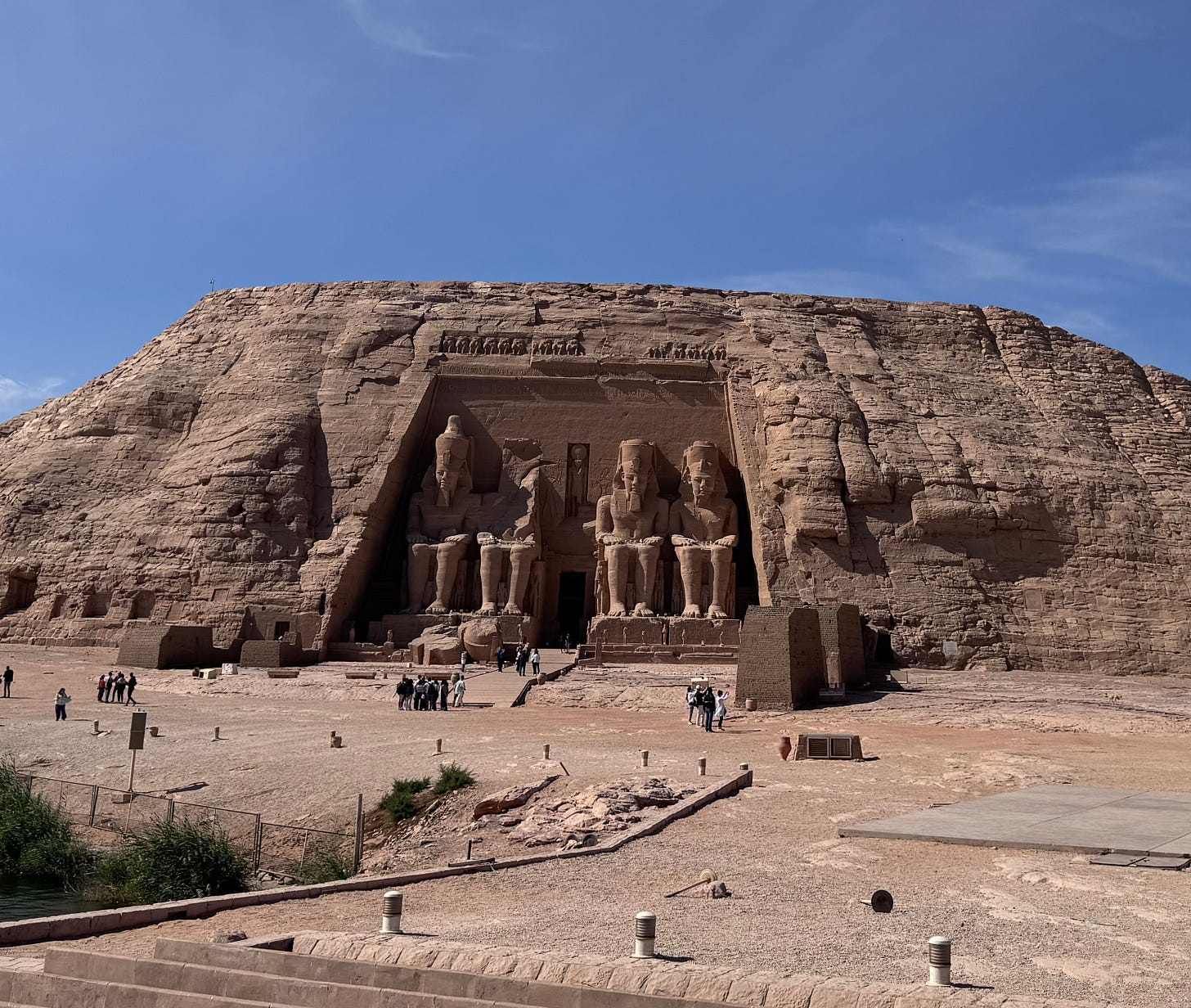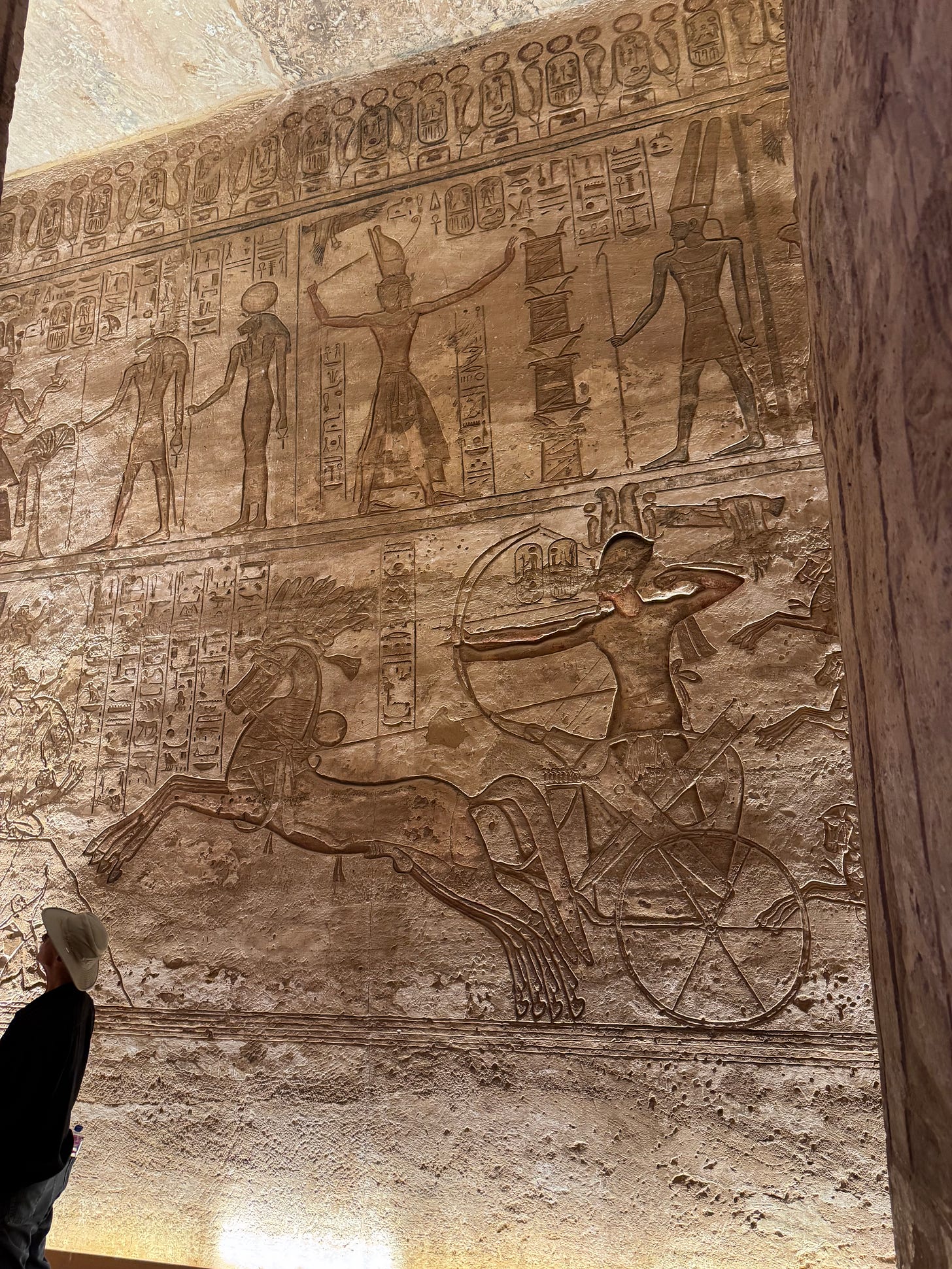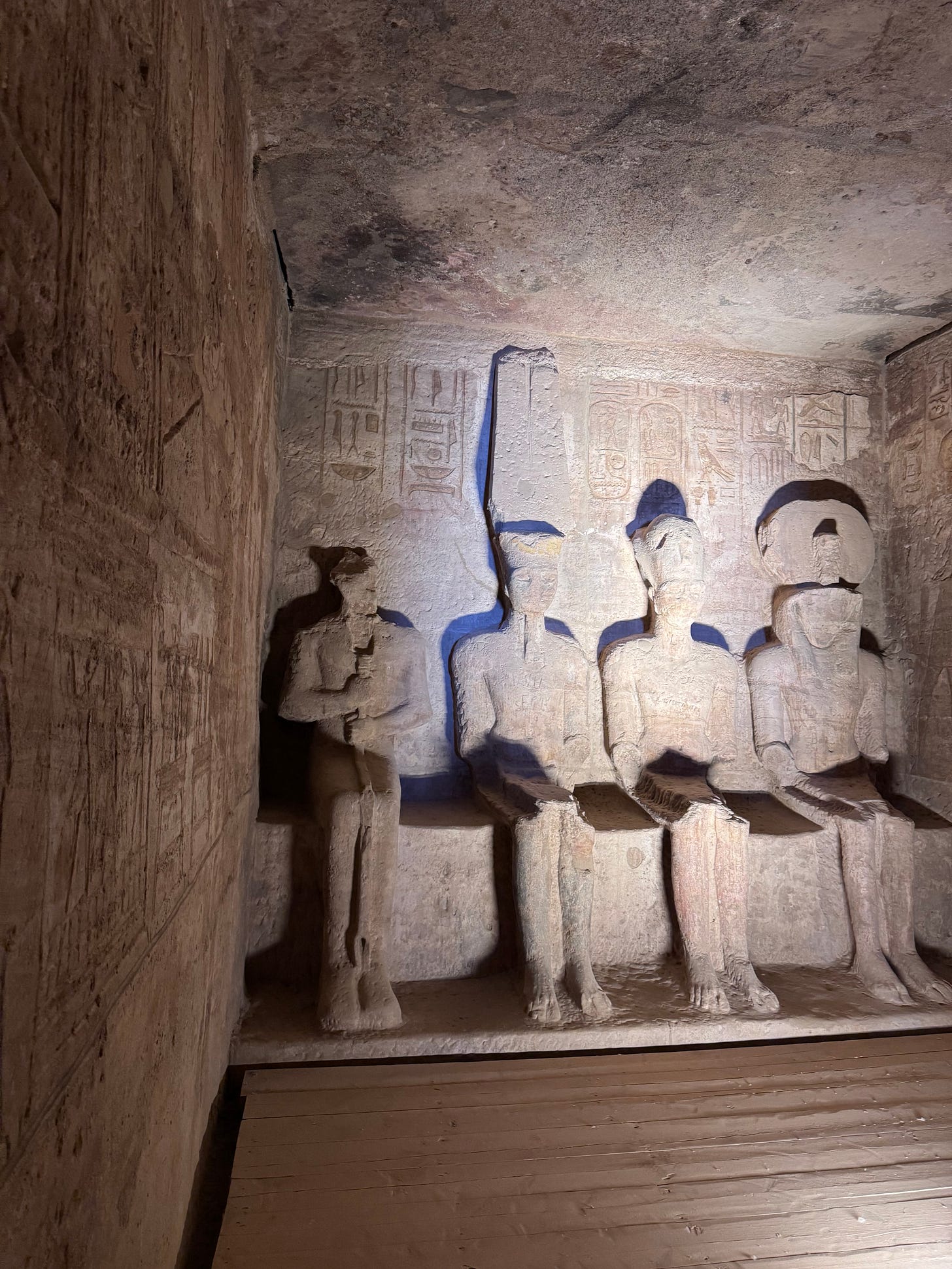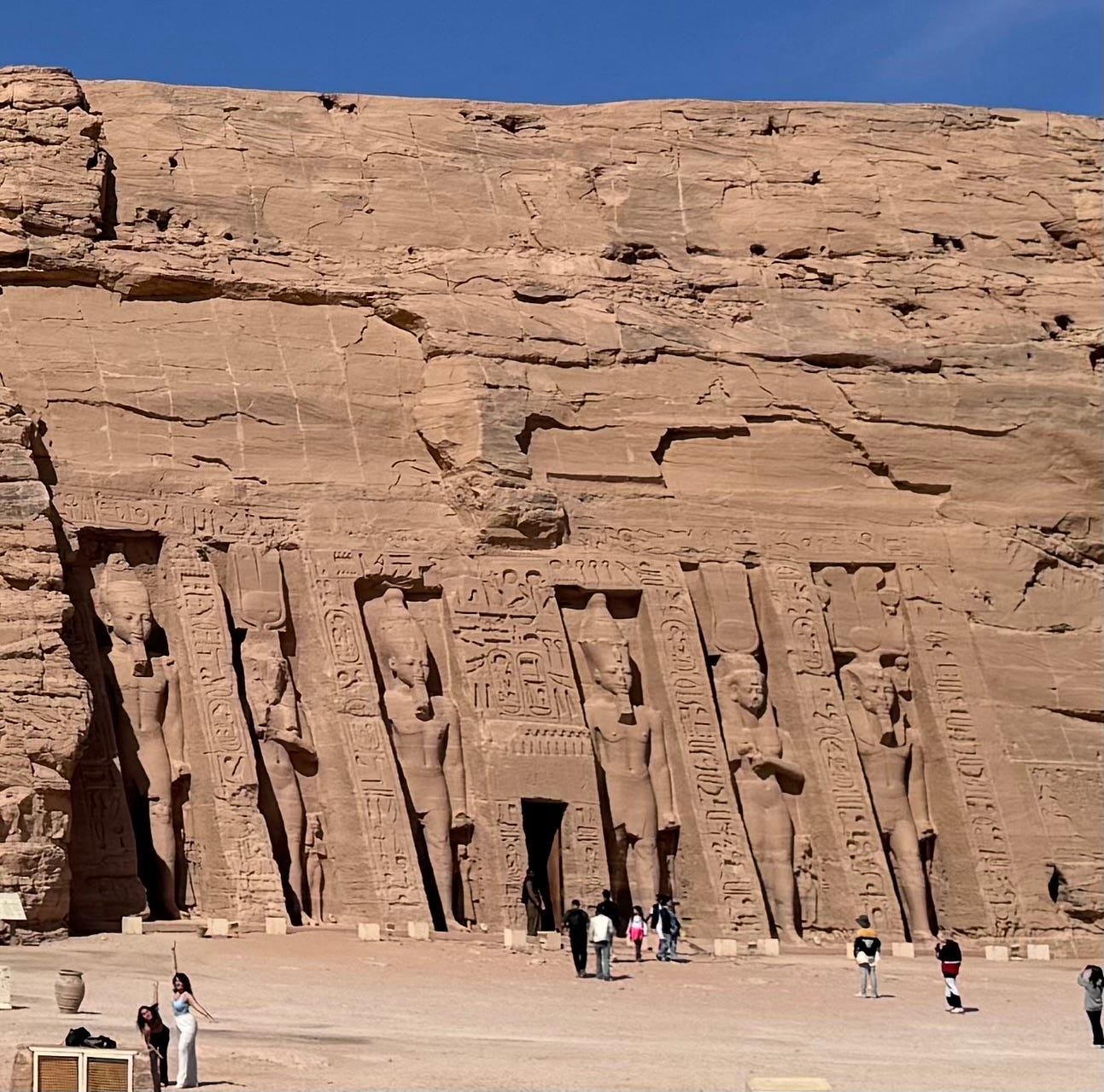The Temples of Abu Simbel
We have turned downstream and are heading back to Luxor
We split up yesterday, the Brilliant Wife electing the shore excursion to the Aswan High Dam, local market visit and Felucca sail. Those who know me and my passion for sailing may think it surprising that I would abandon the chance to sail the Nile with my beautiful bride. But the Temples at Abu Simbel were calling me.
Those of us going to Abu Simbel also visited the Aswan Dam. It’s an engineering marvel that tamed the Nile with tremendous consequences, both good and bad. One of the bad things was the displacement of Nubians living upstream from the dam. We visited one of their new villages today and I hope to discuss the dam and its ramifications in that post.
After a quick visit to the dam we cleared the very tight security at the Aswan Airport and flew 270 kilometers south, over Lake Nasser, which spreads its waters out over the desert, flooding the old river valley and the villages that were sustained by it’s life-giving water and rich soil.
The desert stretches forever, from horizon to horizon, pierced only by the thin green line of the Nile to the north and the waters of Lake Nasser to the south of the massive dam
The few areas of green crop circles, like those in the American West, look like alien polka dots. The irrigating waters of the Lake help grow wheat in these desert oasis.
We landed at Abu Simbel Airport along the shores of Lake Nasser, just 30 kilometers north of the country of Sudan. “Nubia” refers to that region which begins in Aswan at the first cataract of the Nile, where the dam was built, and continues upstream to Khartoum, in central Sudan, at the confluence of the White Nile and Blue Nile, a distance of 600 kilometers. “Nubia” means “Land of Gold.”
Ramses II (1279 - 1213 BCE, New Kingdom, 19th Dynasty) built 2 temples here. One for himself and one for his Great Royal Wife. As the waters of the Nile began to rise the two temples were threatened, seemingly doomed. But thanks to Christiane Desroches-Noblecourt they were saved from destruction. Her efforts, described in Empress of the Nile: The Daredevil Archaeologist who Saved Egypt’s Ancient Temples from Destruction, by Lynne Olson, permits us to enjoy these ancient wonders today.
Above: two of the four statues of Ramses II which adorn the outside of the main temple.
Each of the two temples are very special. The larger one, “The Great Temple,” shown in the opening photo, celebrates Ramses II, in honor of the god Amun-Re, and is dedicated to war, celebrating his military victories, particularly at the Battle of Kadesh, in which the young Ramses II defeated the Hittites, shown above.
The Great Temple has three sections. The innermost, and smallest, contains the statues of four gods. These are Râ-Horakhty (sun god), the deified Ramses II, Amen-Râ (god of Thebes) and Ptah (god of Memphis).
Ptah is the god of darkness. While the other three gods are illuminated twice a year by the sun, Ptah remains dark.
The other temple (“Small Temple”) honors Nefertari, the Great Royal Wife. Ramses II had at least 6 principal wives and an inestimable number of concubines. He fathered over a hundred children. But his favorite wife was the beautiful Nefertari.
Besides “Great Royal Wife,” Ramses gave Nefertari other titles, including
The Most Beautiful in the World
The Beloved
She without equal
She who resembles a Star
She who appears at the beginning of a Great Year.
After their son Amenherkhopshef was born and named “Crown Prince and Heir,” Nefertari was given the title “Royal Mother,” as mother of the future king.
Later she was also given the titles of “The Wife of God” and “Daughter of Amen.” Hard to beat that!
She began to play the role of the goddess Hathor. Unusually she is portrayed as equal to her husband. Even though her temple was a bit smaller than his, she is shown participating in the same rituals and is depicted as of the same height as her god-husband, which is very unusual.
While she never actually reigned as did her predecessor Queen Hatshepsut, she ruled Egypt behind closed doors. Ramses II sought her opinion on everything. As a Priestess of Hathor she was mistress of music, joy, beauty and love.
The Small Temple celebrated love and the love goddess Isis.
The quality of these temples is incredible. They were buried in sand for thousands of years, preserving them from defacement. A shepherd by the name of Abu Simbel discovered them in 1817.
The temples were carved right into the living rock of the mountain. As the waters of the Nile rose behind the dam a tremendous effort of engineering and hard work saved this amazing place. Money was provided in part by UNESCO, partially financed by contributions from school children around the world.
The moving of the temple itself was amazing, a tremendous feat described in a film shown at the visitor’s center. I took extensive video of these temples and will put them up on YouTube once we are home.
We have turned downstream and just docked at Kom Ombo after a busy day. It was so nice to spend the day back with the BW. As our voyage draws to a close, I am reminded of how quickly life goes by. We can never return.
We must all set our watches by the clock of fate. There is a headlong, forthright tide, that bears away man with his fancies like a straw, and runs fast in time and space. It is full of curves … and yet, rightly thought upon, never returns at all. For though it should revisit the same acre of meadow in the same hour, it will have made an ample sweep between whiles; many little streams will have fallen in; many exhalations risen towards the sun; and even although it were the same acre, it will no more be the same river.
Credit: The Letters of Robert Louis Stevenson: An Inland Voyage, Word Press
Thanks so much for traveling along. It’s been a wonderful trip. So happy you are here.
Tomorrow I hope to have a very special post on the Nubians and the Aswan Dam.












Notable synchronicity: the Jan/Feb 2025 issue of National Geographic History features the story “Nubian Pharaohs, the Ruled Became Egypt’s Rulers”.
Wooo-Hooo. Continued emphasis on an enlarged story of the peoples of ancient Egypt.
Maybe you should give your wife a name like Nefertari or at least change it to "Most Brilliant Wife in the world". I know it is a mouthful, but she does probably deserve it.